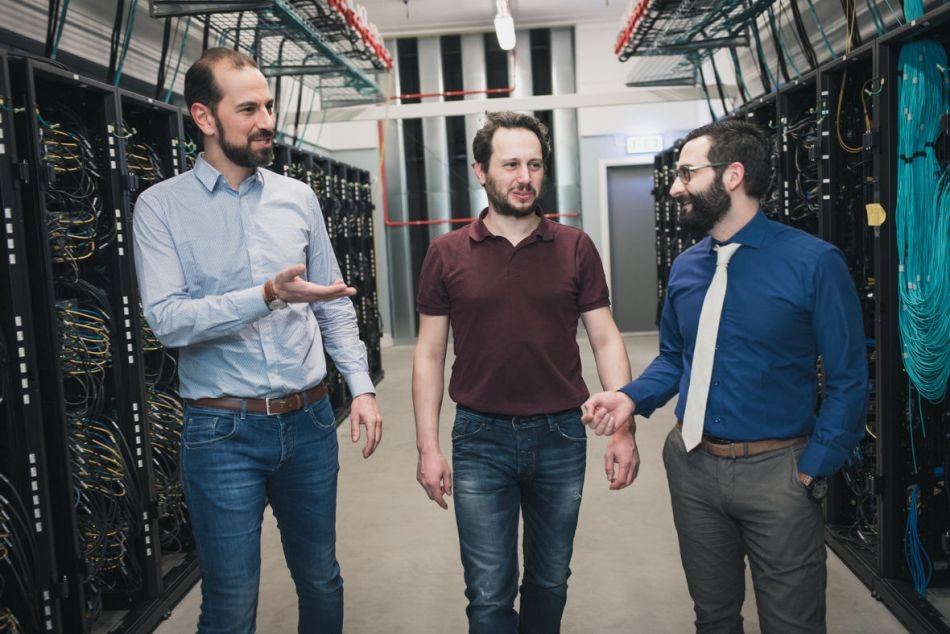Mar 11 2019
Scientists at Linköping University have built a theoretical model that allows simulations for demonstrating what takes place in hard cutting materials as they degrade. The model will enable the manufacturing sector to save money and time. The model has been described in the open access scientific journal Materials.
 Kostas Sarakinos, Davide Sangiovanni, and Georgios Almyras in National supercomputer centre (NSC) at LiU. (Image credit: Anna Nilsen)
Kostas Sarakinos, Davide Sangiovanni, and Georgios Almyras in National supercomputer centre (NSC) at LiU. (Image credit: Anna Nilsen)
Metal cutting tools are usually coated with titanium-aluminum nitride a ceramic material. With the help of a titanium-aluminum nitride thin film, the coated tool’s cutting edge becomes harder, and the service life of the tool is extended. A very specific feature of the coated surface is that it becomes even harder during the cutting process, an occurrence that is referred to as age hardening.
Kostas Sarakinos, associate professor in materials science at Linköping University, explains that the material is considered as a workhorse in the manufacturing sector.
Sensitive to high temperature
The alloy is, however, prone to high temperature. A few minutes of the cutting operation of a truly hard material exposes the tool’s cutting edge to such a high pressure that it is heated to almost 900° or above. At temperatures up to 700°, the material is unscathed, but as the temperature increases, it begins to degrade. The edge becomes softer and loses sharpness.
Thus far, scientists have not been able to establish what occurs at the atomic level within the thin film during the cutting process. It has only been possible to partly mimic the properties of the multifaceted combination of aluminum, titanium, and nitrogen, and it has not been possible to gain any deductions from the outcomes.
Georgios Almyras, who formerly worked as a post-doctoral researcher at the Nanoscale Engineering Division and has currently moved to Ericsson, Davide Sangiovanni of the Division of Theoretical Physics, and Kostas Sarakinos, head of the Nanoscale Engineering Division, have after four years’ research built a reliable theoretical model that can be used to display precisely what occurs in the material, with picosecond time resolution. They have used the recently developed model to mimic events in the material, pinpointing which atoms are displaced and the significances this has for the properties.
“This also means that we can develop strategies to stop the degradation, such as alloying the materials or creating specially-designed nanostructures”, says Davide Sangiovanni.
Supercomputer calculations
Their theoretical model computes the forces between the atoms in the material. The model is based on a formerly known technique that has been effectively used in basic material systems. Multifaceted combinations of materials, however, require laborious calculations that are only viable using a supercomputer. The research team from LiU has enhanced these calculations by executing machine learning algorithms which are the forerunners of artificial intelligence.
The supercomputer at the National Supercomputer Centre at LiU was then used to carry out calculations of about 40 alloys of the three elements titanium, aluminum, and nitrogen, while examining more than a few properties of the material. The researchers have then compared the findings from the calculations with the identified properties of the materials.
The agreement is very good. It’s important that we have calculated also properties that we know, because then we can be sure that the calculations and predictions of the model are reliable.
Kostas Sarakinos, Head of the Nanoscale Engineering Division, Linköping University
The scientists anticipate that the technique will be beneficial for companies in the manufacturing sector, for example, ABB, Sandvik, Seco Tools, etc., which could save plenty of money by designing tools with superior hardness and resistance to wear. LiU scientists have had long-term collaboration agreements with these companies.
We can now for the first time carry out large-scale classical simulations of atomic structures in one of the material systems most commonly used for metal cutting and forming. The simulations can consider resistance to heat or nanostructures, and they may provide important insight into how the atoms move. The results will help us avoid, or at least delay, degradation of the material.
Kostas Sarakinos, Head of the Nanoscale Engineering Division, Linköping University